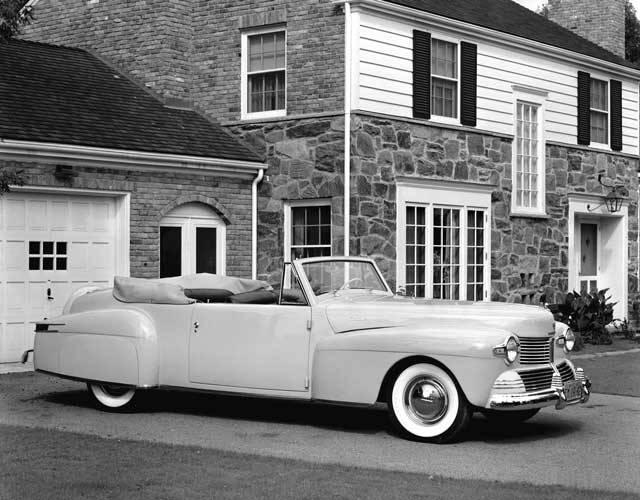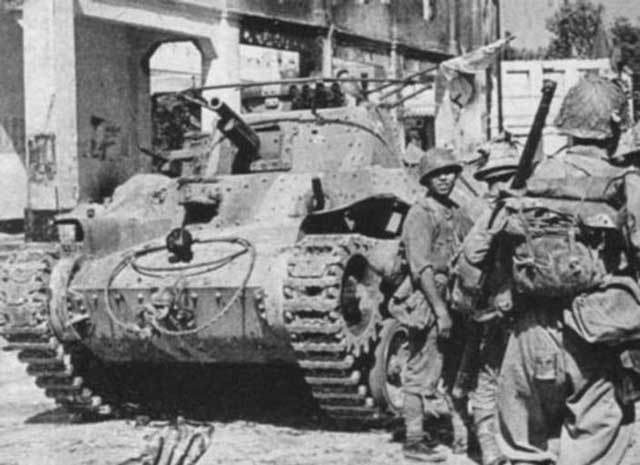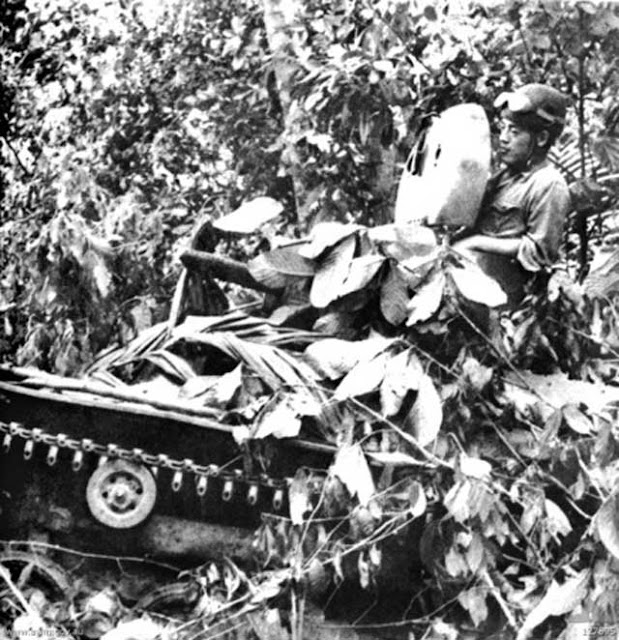Tuesday 10 February 1942
 |
| "Der Adler", Nr. 3, 10 February 1942. |
American Homefront: Pursuant to an order issued by Donald M. Nelson, Chairman of the War Production Board, all remaining car production in the United States ceases on 9 February 1942. In a well-publicized event, the last civilian car is completed for the duration at the River Rouge Ford Plant. This order benefits the war effort in two ways. First, automobile production consumes a huge percentage of the United States' strategically important raw materials (for instance, 51% of malleable iron, 75% of plate glass, 68% of upholstery leather, 80% of rubber). This frees the materials up for war production. Second, the production lines are rapidly being converted to military goods.
 |
| A 1942 Lincoln. As an indication of how far World War II set the automotive industry back, consider that Ford offered an automatic transmission on 1942 Lincolns and Mercurys, the "Liquamatic," as an option. Ford quickly withdrew it for reasons unknown and did not offer another automatic transmission until 1951. |
Automotive production lines ultimately produce 50% of all aircraft engines, 33% of all machine guns, 80% of tanks and tank parts, 100% of all Army trucks, and 50% of all diesel engines used by the military. Perhaps the auto manufacturers' most vital contribution is the production of 27,000 complete aircraft, including most of the B-24s that enter service at the Willow Run plant. Other vital goods also flow from the auto production lines, including 20% of all munitions production.
 |
| An article in the 10 February 1942 Der Adler military magazine summarizes the war in the Pacific. On the right is a summary of Ritterkreuz (Knight's Cross) winners. Medals were extremely important in the Wehrmacht and gave certain solders prestige and fame far beyond that usually accorded their rank. |
Battle of the Pacific: With the Japanese holding a large swathe of northwestern Singapore, General Sir Archibald Wavell, Commander in Chief ABDA, arrives by air to review the situation. He orders the island held, which the local generals do not consider very difficult, but also orders all remaining RAF personnel to fly to bases in the Netherlands East Indies. The situation on the ground continues to deteriorate for the British, with the Japanese now able to ferry across artillery and even armor to northwest Singapore. The 11th Indian Infantry Division (Major-General B. W. Key) makes a desperate counterattack against Japanese troops which have seized the heights to the south of the Causeway, but this fails. The overall commander of all Allied forces in Singapore, Lieutenant-General Arthur Percival, orders a secondary defensive line behind the main defensive line around Jurong in the west, but subordinate commanders misinterpret this to mean a general withdrawal to the east. This leads to a collapse of the Kranji-Jurong Switch Line. General Wavell orders Percival to launch a quick counterattack to re-establish the line, but through muddled communications and lack of ready troops, this counterattack does not take place before the Japanese launch further attacks in the sector.
 |
| Japanese troops during the Battle of Bukit Timah, 10 February 1942. That is a Type 97 'Chi-Ha' medium tank. |
In London, Prime Minister Winston Churchill is dismayed at the reports that he is receiving from Singapore. He cables General Wavell:
I think you ought to realize the way we view the situation in Singapore. It was reported to Cabinet by the CIGS [Chief of the Imperial General Staff, General Alan Brooke] that Percival has over 100,000 [sic] men, of whom 33,000 are British and 17,000 Australian. It is doubtful whether the Japanese have as many in the whole Malay Peninsula ... In these circumstances, the defenders must greatly outnumber Japanese forces who have crossed the straits, and in a well-contested battle, they should destroy them. There must at this stage be no thought of saving the troops or sparing the population. The battle must be fought to the bitter end at all costs. The 18th Division has a chance to make its name in history. Commanders and senior officers should die with their troops. The honor of the British Empire and of the British Army is at stake. I rely on you to show no mercy to weakness in any form. With the Russians fighting as they are and the Americans so stubborn at Luzon, the whole reputation of our country and our race is involved. It is expected that every unit will be brought into close contact with the enemy and fight it out.
While Churchill somewhat overstates the number of Allied troops in Singapore, he is generally correct that the British outnumber the Japanese. However, the Japanese have battle-hardened, disciplined troops who have a record of victories down the length of the Malay Peninsula. The British have many service troops, bureaucrats, and unarmed troops (thanks to Japanese sinkings of supply ships). They also are victims of poor leadership and an extremely difficult defensive posture with many areas of vulnerability and little air support.
 |
| The U.S. Navy only now has gotten around on 10 February 1942 to provide official notifications to next of kin of those who perished during the Pearl Harbor attack on 7 December 1942. Here is a notice about Chicago resident and U.S. Marine Herbert A. Dreesbach. Private Dreesbach, born in 1917, enlisted on 8 October 1940 and was aboard the U.S.S. Arizona as a loader, 5" gun. As with many others who perished on USS Arizona, Private Dreesbach's body was not recovered and is believed to remain aboard the ship. This notice appeared in the Chicago Daily Tribune, 10 February 1942. |
On the Bataan Peninsula in the Philippines, the Allies continue attacking Japanese pockets behind the Main Line of Resistance (MLR). The main remaining pocket is on the western half of the peninsula in the I Corps sector. While these pockets do not represent true threats to the MLR, they are a major distraction for both sides. The Japanese troops under General Homma have pulled back in some areas to concentrate their forces for a final offensive.
 |
| As noted above, Private Herbert Dreesbach perished aboard the USS Arizona. His sister, Elaine H. Dreesbach, enlists in the US Marines in 1944 and is stationed in Hawaii. Chicago Daily Tribune, 25 February 1945. Born in 1919, Elaine later marries, moves to Arkansas, where she has two sons and two daughters and passes away in 2007. |
The Japanese continue advancing on Borneo, taking Banjarmasin and a nearby airfield on the south coast. These are not vital areas for the Allies, but the Japanese are advancing in the direction of Java, the heart of their defenses in the Netherlands East Indies. The 5th Air Force sends some LB-30s (export B-24 Liberators) to attack Japanese shipping in the Makassar Strait. They find, bomb, and damage Japanese seaplane carrier HIJMS Chitose.
 |
| The Michigan Daily of 10 February 1942 has big news - the Regents have adopted a three-Semester school year. Oh, and over on the left is news that the Japanese have invaded Singapore Island in a night assault. |
About 2000 US Army troops arrive on Christmas Island, Line Islands. The large defensive forces on Christmas Island also includes P-39s of the USAAF 7th Air Force's 12th Pursuit Squadron, 50th Pursuit Group.
Japanese submarine HIJMS I-69 once again shells Midway Island. However, this time the defending Americans strike back, sending F2A Buffalo fighters of the Marine Fighting Squadron VMF-211 to bomb it. The fighters strafe I-69, lightly damaging it and forcing the submarine to return to Kwajalein for repairs.
The Japanese bomb and sink 5236-ton American tanker Mindanao. The Japanese will raise the Mindanao later in 1942, rename it Palembang Maru, and put it into service until it is sunk by air attack on 4 March 1945 off Saigon.
 |
| HMS Eagle on 10 February 1942 (Imperial War Museum). |
Eastern Front: The Wehrmacht has suffered serious losses during the winter when they had planned on building up their forces during an inactive period. This is due to the successful Red Army counteroffensive which began around Moscow and spread both north and south. Army Group Center takes 110,000 casualties during February and receives 70,000 replacements. Since the Soviet counteroffensive began in early December, the Army Group is short 227,000 troops. About a quarter of the replacements are men returning from hospitals, while many of the others are untrained men who previously have been deferred.
 |
| The Cypriot Mule Corps in the Western Desert, North Africa,10 February 1942 (Imperial War Museum). |
European Air Operations: The RAF launches its major operation in February, sending 55 bombers to attack Bremen, three Whitleys to bomb Emden, and one bomber each to attack Borkum, Cuxhaven, and Wilhelmshaven. RAF Bomber Command also sends 20 bombers (12 Wellingtons and 8 Stirlings) to attack the German naval base at Brest, but the area is covered by heavy clouds and little is accomplished there. The RAF incurs no losses in these operations.
 |
| An article in the 10 February 1942 Der Adler about combat in Finnland. |
The British still are completely unaware that the Kriegsmarine is planning its Channel Dash (Operation Cerberus) to begin from Brest after dark on 11 February. Adolf Galland, in overall command of the critical air portion of the operation, completes the last of eight rehearsals for the operation. His plan is to have fighters circling very low around the ships as they dash up the channel, avoiding British radar until the ships are sighted and the RAF appears. Everything is meticulously planned, and the air portion of the Channel Dash has the codename Unternehmen Donnerkeil (Operation Thunderbolt).
The Luftwaffe continues its operations against British shipping, damaging 3176-ton British freighter Lieutenant Robert Mory about five miles west of Trevose Head.
 |
| A helpful article on 10 February 1942 Der Adler discusses the mascots of Luftwaffe units. These could be cartoon characters, animals, or abstract symbols. For instance, the man with the cane in the middle-right of the left page is the cartoon character Adamson, used in the 4th, then 8th Staffel of elite fighter squadron JG 26. JG 26 was perhaps the Luftwaffe unit best known to Allied fighter pilots, as it served on the Channel front throughout the war. |
Battle of the Atlantic: A mine sinks 3648-ton German freighter off Borkum, west of Vlieland, the Netherlands. This sinking sometimes is attributed to a torpedo from an unknown source, but a mine seems more likely, especially considering that RAF recently has dropped numerous mines in the general vicinity.
Battle of the Mediterranean: The two sides have settled down to garrison duty after the Afrika Korps' rapid advance past Benghazi. Off the coast, U-652 (Oblt. Georg-Werner Fraatz), on its fifth patrol out of La Spezia, attacks a British tanker off Sidi Barrani but misses. After dark, a Luftwaffe attack on the village of Qormi, which is packed with refugees, kills 16 people and destroys 30 houses.
 |
| A good view of the Adamson character used on planes in 8/JG 26. |
German/Romanian Relations: Romanian dictator (Conducător) Ion Antonescu arrives in Rastenburg, East Prussia, for a two-day visit with Adolf Hitler. Romania is the Reich's only source of natural oil and also has a well-respected army which incurred heavy casualties taking Odessa in 1941. Hitler already is thinking ahead to the summer campaign and presses Antonescu to provide large formations for a major offensive in the Army Group South sector. Antonescu agrees but asks for modern weaponry and the transfer of northern Transylvania from Hungary, which would reverse the Second Vienna Award of 30 October 1940. Hitler basically replies that he will think about both requests but he ultimately never grants them. This is a reminder to everyone that Romania and Hungary are almost more interested in fighting each other over their conflicting claims in Eastern Europe as they are in defeating the Soviet Union. Throughout the war, Romanian and Hungarian units are always separated by Wehrmacht formations.
 |
| Death notices are a fact of life... and death ... during wartime. Here is one from the 10 February 1942 LA Daily World regarding a US Marine, Russell John Durio, killed in action at Pearl Harbor. He was born in 1922, had enlisted on 12 October 1940, and was aboard the USS Arizona. His body is believed to be still aboard USS Arizona. |
Finnish Military: The Finnish Army upgrades its Tank Battalion to an armored brigade.
US Military: The Fifth Air continues redeploying its forces. It sends the air echelon (B-17s) of the 88th Reconnaissance Squadron (Heavy), 7th BG (Heavy) from Hickam Field, Hawaii, to Fiji.
British Homefront: Soap rationing begins in Great Britain.
 |
| Look magazine, 10 February 1942. "Why America Can't Lose" is a feature article. The lady pictured on the cover is actress Elyse Knox, future wife of football star Tom Harmon. Mrs. Harmon passed away in 2012. |
February 1942February 1, 1942: The US Navy Strikes BackFebruary 2, 1942: Germans Recovering in RussiaFebruary 3, 1942: Japanese Shell and Bomb SingaporeFebruary 4, 1942: Battle of Makassar StraitFebruary 5, 1942: Empress of Asia SunkFebruary 6, 1942: The Christmas Island BodyFebruary 7, 1942: The Double-V CampaignFebruary 8, 1942: Japan Invades SingaporeFebruary 9, 1942: French Liner Normandie CapsizesFebruary 10, 1942: US Car Production EndsFebruary 11, 1942: Tomforce Fails on SingaporeFebruary 12, 1942: The Channel DashFebruary 13, 1942: Japanese Paratroopers In ActionFebruary 14, 1942: RAF Orders Terror RaidsFebruary 15, 1942: Japan Takes Singapore
February 17, 1942: Indian Troops Defect to JapaneseFebruary 18, 1942: Battle of Badung StraitFebruary 19, 1942: FDR Authorizes Internment CampsFebruary 20, 1942: O'Hare the HeroFebruary 21, 1942: Crisis in BurmaFebruary 22, 1942: Bomber Harris Takes OverFebruary 23, 1942: Bombardment of Ellwood, CaliforniaFebruary 24, 1942: US Raid on Wake IslandFebruary 25, 1942: Battle of Los AngelesFebruary 26, 1942: Gneisenau EliminatedFebruary 27, 1942: Battle of Java SeaFebruary 28, 1942: Battle of Sunda Strait2020






















